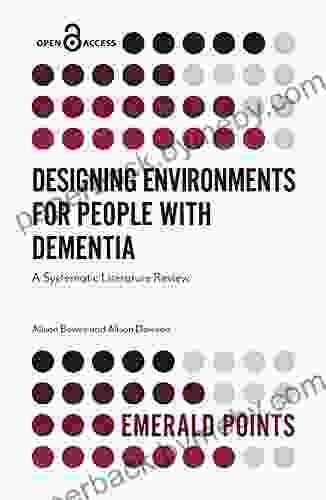Designing Environments for People with Dementia: Enhancing Well-being and Quality of Life


4.3 out of 5
| Language | : | English |
| Text-to-Speech | : | Enabled |
| Enhanced typesetting | : | Enabled |
| Word Wise | : | Enabled |
| File size | : | 1066 KB |
| Screen Reader | : | Supported |
| Print length | : | 136 pages |
Dementia is a complex and progressive condition that affects millions of people worldwide. As the population ages, the number of individuals living with dementia is expected to rise significantly. Creating supportive environments that meet the unique needs of people with dementia is crucial for enhancing their well-being and quality of life.
This comprehensive guide provides evidence-based design principles and practical strategies for designing environments that promote orientation, reduce agitation, and foster a sense of belonging and purpose. With a focus on person-centered care and aging-in-place, this guide empowers healthcare professionals, architects, interior designers, and family caregivers to create environments that support the cognitive, emotional, and physical needs of individuals with dementia.
Evidence-Based Design Principles
Evidence-based design (EBD) is a systematic approach to designing environments that improve health outcomes. In the context of dementia care, EBD involves incorporating research findings and best practices into the design process to create environments that enhance the well-being of individuals with dementia.
Key EBD principles for designing environments for people with dementia include:
- Orientation: Providing clear and consistent cues to help individuals with dementia find their way around and understand their surroundings.
- Wayfinding: Designing spaces that are easy to navigate, with clear signage and landmarks that promote orientation and wayfinding.
- Cognitive Stimulation: Creating environments that stimulate cognitive function and support memory, attention, and problem-solving abilities.
- Sensory Stimulation: Incorporating elements that stimulate the senses (sight, hearing, touch, smell, taste) to enhance well-being and reduce agitation.
- Safety: Designing spaces that are safe and secure, reducing the risk of falls, wandering, and other accidents.
- Dignity: Creating environments that respect the dignity and individuality of people with dementia, promoting a sense of belonging and purpose.
Practical Strategies for Design
Based on the EBD principles outlined above, here are some practical strategies for designing environments for people with dementia:
Color and Lighting
- Use high-contrast colors to differentiate between spaces and objects, making them easier to see and identify.
- Avoid using overly bright or flickering lights, which can cause discomfort and agitation.
- Provide natural light whenever possible, as it helps regulate sleep-wake cycles and improves mood.
Layout and Floor Plan
- Create simple and easy-to-navigate floor plans, reducing the risk of confusion and disorientation.
- Use clear and consistent signage to help individuals find their way around.
- Provide multiple paths and landmarks to promote wayfinding and reduce the likelihood of getting lost.
Furnishings and Equipment
- Choose furniture that is comfortable, supportive, and easy to move around.
- Use non-slip flooring and grab bars to reduce the risk of falls.
- Provide assistive technology, such as wander alarms and medication reminders, to support safety and independence.
Sensory Stimulation
- Incorporate sensory elements, such as music, scents, and tactile surfaces, to stimulate the senses and reduce agitation.
- Create sensory gardens or indoor spaces with plants, water features, and natural elements to provide soothing and calming experiences.
- Use aromatherapy and light therapy to enhance mood and promote relaxation.
Dignity and Belonging
- Involve people with dementia in the design process, respecting their preferences and experiences.
- Create spaces that are familiar and meaningful, triggering positive memories and a sense of belonging.
- Provide opportunities for social interaction and community involvement, fostering a sense of purpose and well-being.
Designing environments for people with dementia requires a holistic approach that incorporates evidence-based principles and practical strategies. By creating supportive spaces that promote orientation, reduce agitation, and foster a sense of belonging and purpose, we can significantly enhance the well-being and quality of life for individuals living with dementia.
This comprehensive guide provides a wealth of knowledge and resources for healthcare professionals, architects, interior designers, and family caregivers who are involved in the design of dementia care environments. By working together, we can create environments that support the cognitive, emotional, and physical needs of people with dementia, enabling them to live with dignity and respect.
Remember, a well-designed environment can make a world of difference in the lives of people with dementia and their families. By embracing the principles and strategies outlined in this guide, we can create environments that support their well-being and help them thrive in the face of this challenging condition.
4.3 out of 5
| Language | : | English |
| Text-to-Speech | : | Enabled |
| Enhanced typesetting | : | Enabled |
| Word Wise | : | Enabled |
| File size | : | 1066 KB |
| Screen Reader | : | Supported |
| Print length | : | 136 pages |
Do you want to contribute by writing guest posts on this blog?
Please contact us and send us a resume of previous articles that you have written.
 Book
Book Novel
Novel Page
Page Chapter
Chapter Text
Text Story
Story Genre
Genre Reader
Reader Library
Library Paperback
Paperback E-book
E-book Magazine
Magazine Newspaper
Newspaper Paragraph
Paragraph Sentence
Sentence Bookmark
Bookmark Shelf
Shelf Glossary
Glossary Bibliography
Bibliography Foreword
Foreword Preface
Preface Synopsis
Synopsis Annotation
Annotation Footnote
Footnote Manuscript
Manuscript Scroll
Scroll Codex
Codex Tome
Tome Bestseller
Bestseller Classics
Classics Library card
Library card Narrative
Narrative Biography
Biography Autobiography
Autobiography Memoir
Memoir Reference
Reference Encyclopedia
Encyclopedia Kevin Leman
Kevin Leman Leonie Van De Vorle
Leonie Van De Vorle Kenneth E Hagin
Kenneth E Hagin Kevin D Hoover
Kevin D Hoover Kerry Andy Ph D
Kerry Andy Ph D Ken Wlaschin
Ken Wlaschin Mary Kubica
Mary Kubica Stephen Orr
Stephen Orr William L Cleveland
William L Cleveland Myriam Jimeno
Myriam Jimeno S Daniel Abraham
S Daniel Abraham Ken Warner
Ken Warner Ken Gullette
Ken Gullette Tom Mattson
Tom Mattson United States Government Us Army
United States Government Us Army Keshav Ramesh
Keshav Ramesh R F Egerton
R F Egerton Kev Ashcroft
Kev Ashcroft Ralph Cockburn
Ralph Cockburn Mia Sheridan
Mia Sheridan
Light bulbAdvertise smarter! Our strategic ad space ensures maximum exposure. Reserve your spot today!

 Terry PratchettUncover the Lost World of Vikings in America and Other Historical Treasures
Terry PratchettUncover the Lost World of Vikings in America and Other Historical Treasures José SaramagoFollow ·8.7k
José SaramagoFollow ·8.7k Stanley BellFollow ·13.1k
Stanley BellFollow ·13.1k Gary ReedFollow ·18.4k
Gary ReedFollow ·18.4k David BaldacciFollow ·10.2k
David BaldacciFollow ·10.2k Marc FosterFollow ·4.7k
Marc FosterFollow ·4.7k Harvey BellFollow ·11.7k
Harvey BellFollow ·11.7k Dwight BlairFollow ·2.1k
Dwight BlairFollow ·2.1k Junichiro TanizakiFollow ·2.6k
Junichiro TanizakiFollow ·2.6k

 Isaac Asimov
Isaac AsimovEmbark on an Epic Adventure: The Colorado Trail 9th...
Unveiling the Treasures of the Colorado...

 Clinton Reed
Clinton ReedUltimate Football Heroes: Uncover the Gridiron Greatness...
Enter the World...

 Ibrahim Blair
Ibrahim BlairUnveiling the Secrets of Stolen Focus: A Journey to...
In today's relentless digital...

 Colt Simmons
Colt SimmonsRediscover the Founding Father's Vision: Thomas Jefferson...
Immerse Yourself in the Unedited Words of...

 Juan Butler
Juan ButlerExcel in Language Learning: The Ultimate Self-Study...
Unlock Your Language Potential with Our...
4.3 out of 5
| Language | : | English |
| Text-to-Speech | : | Enabled |
| Enhanced typesetting | : | Enabled |
| Word Wise | : | Enabled |
| File size | : | 1066 KB |
| Screen Reader | : | Supported |
| Print length | : | 136 pages |












